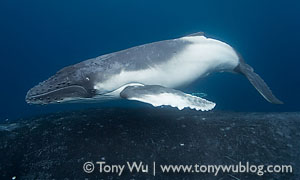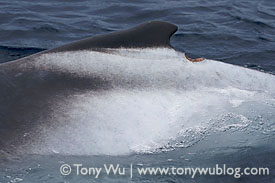 It's been a slow start to the whale season this year. As of the time I arrived in Tonga on 27 June, there weren't many whales around, and no one had seen a baby whale.
It's been a slow start to the whale season this year. As of the time I arrived in Tonga on 27 June, there weren't many whales around, and no one had seen a baby whale.
Though it's still early in the season, usually by now, there are plenty of whales, including quite a few juveniles. Last year for example, we had half-a-dozen or more extended encounters with whales during the last week of July.
As I walked around town to say hello to everyone, there was an underlying sense of concern. Without fail, everyone mentioned that there had been no calf sightings yet. Though unusual, it didn't really worry me much...until I went out on the water.
 More than once in the past when everyone else was unable to find whales, I've generally been luckier than most, and have managed to find friendly whales even in the midst of apparent whale-droughts.
More than once in the past when everyone else was unable to find whales, I've generally been luckier than most, and have managed to find friendly whales even in the midst of apparent whale-droughts.
After my first day out on the water though, it was clear that something was different.
Like most things in nature, it's difficult to know for certain why there were no newborn whales around, but one thing was certain...the babies were nowhere to be found.
Puppy Power
Before heading out to sea, I spent a couple of days acclimating to the time zone, and generally recovering from the arduous transglobal flight path I took to get here. Over a seven-day period, I had but one full night's sleep.
The balance of the nights (or days, depending upon which time zone I arbitrarily decided to place myself in) I was either on a boat, plane or in a transit lounge. By the time I hit my bed in Tonga, it had been about 47 hours since I'd slept.
To stay awake during the day, I walked around Vava'u taking photos. For whatever reason, there seemed to be an overwhelming number of puppies around. One particularly cute litter I came across numbered eight (originally 11, but three had already been given away).
As the sun slowly set, the mommy dog (who looked exactly as you'd expect a mother of 11 to look) overcame her initial wariness and let her puppies play with us.
Words can't describe how playful and adorable they were, or how much fun I had interacting with them. They'd flop around for a while, fall suddenly asleep, then wake up and run around in endless circles again...the perfect distraction for overcoming jetlag.
Paying Dues
Of course, part-and-parcel of all nature photography is paying your dues. Three days out on the water...three days without much to show.
We had several encounters with active whales that treated us to some nice surface displays, and we got into the water during a couple of heat runs, but overall, the weather was rough, seas choppy and whales uncooperative.
Yesterday, the skies looked particularly grey and ominous. Winds were up at 10 knots or so, and the sea was acting up. Based solely on gut feeling, we decided to head out.
Experience and gut feeling paid off. Almost exactly at noon, we found the very first calf of the season, given away by a tiny puff of water vapour when it breathed. We spent an hour or so letting the mother grow accustomed to our presence, then entered the water.
 Soon, we were face-to-face with a beautiful baby whale and a very calm mother, who brought her baby close to us as she passed. The baby was clearly very young, probably born in the past few days, with lots of white all over its body.
Soon, we were face-to-face with a beautiful baby whale and a very calm mother, who brought her baby close to us as she passed. The baby was clearly very young, probably born in the past few days, with lots of white all over its body.
For obvious reasons, we named the baby "Hina Hina", which means "white" in Tongan.
Hina Hina's playfulness, curiosity and general floppiness reminded me of the puppies I'd photographed a few days earlier. At one point, the baby came directly to our boat, swimming alongside for a while, before making its way back to the waiting mother.
With Hina Hina's appearance, the 2007 season has officially begun!
 Though it's tempting to get all warm and gushy about how cute Hina Hina is (believe me, we all got pretty gushy), there was one clear reminder of the harsh reality facing Hina Hina.
Though it's tempting to get all warm and gushy about how cute Hina Hina is (believe me, we all got pretty gushy), there was one clear reminder of the harsh reality facing Hina Hina.
Though the baby whale was only days old, it already had a chunk bitten out of its back, perhaps by a shark. Hina Hina's challenge in the next few months is to eat, grow, avoid predators and become strong enough to make it back to the Antarctic to mature. Hopefuly, Hina Hina will make it, and we'll see him or her back here in the future.
For the time being, it's easy to recognise Hina Hina's mom based on her dorsal fin, so we'll be keeping an eye out for the pair as the weeks go by. Maybe we'll come across Hina Hina again. (More photos of Hina Hina on Flickr)
It's a rainy day today, so time to catch up on emails and sleep...
Update: We found out that "white" in Tongan is actually "Hine Hina". Oh well, "Hina Hina" is cute, so it stays.